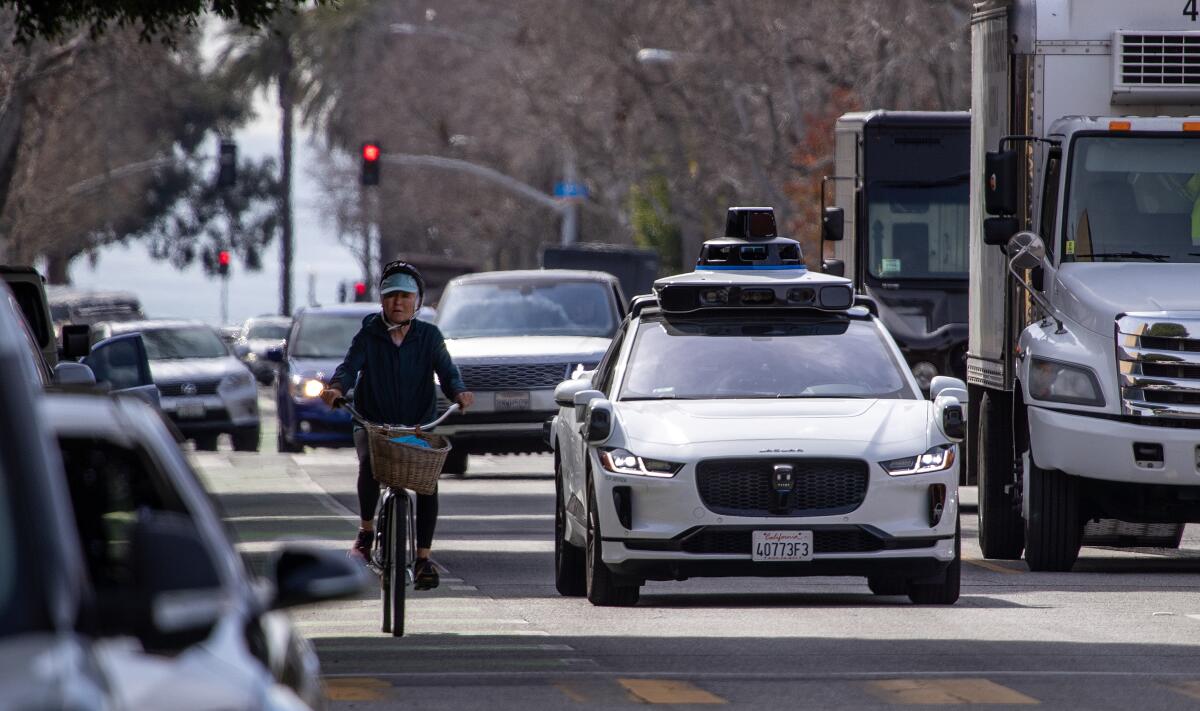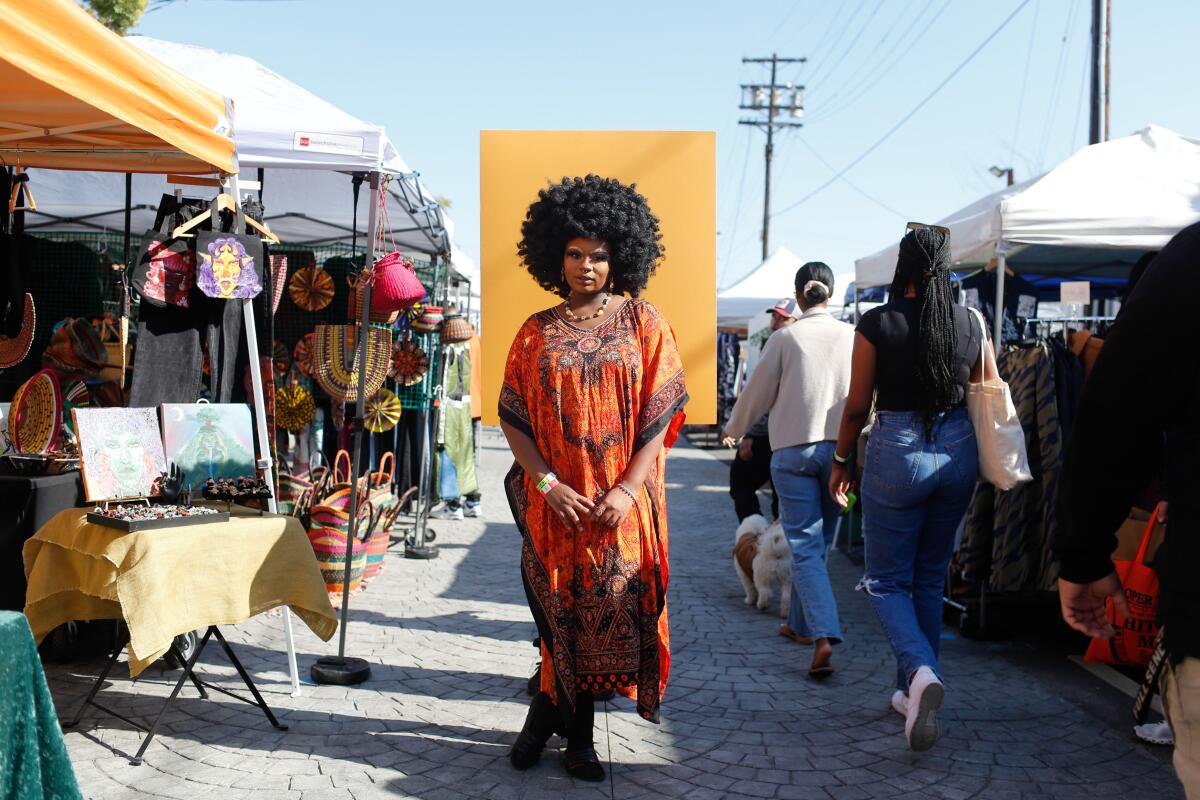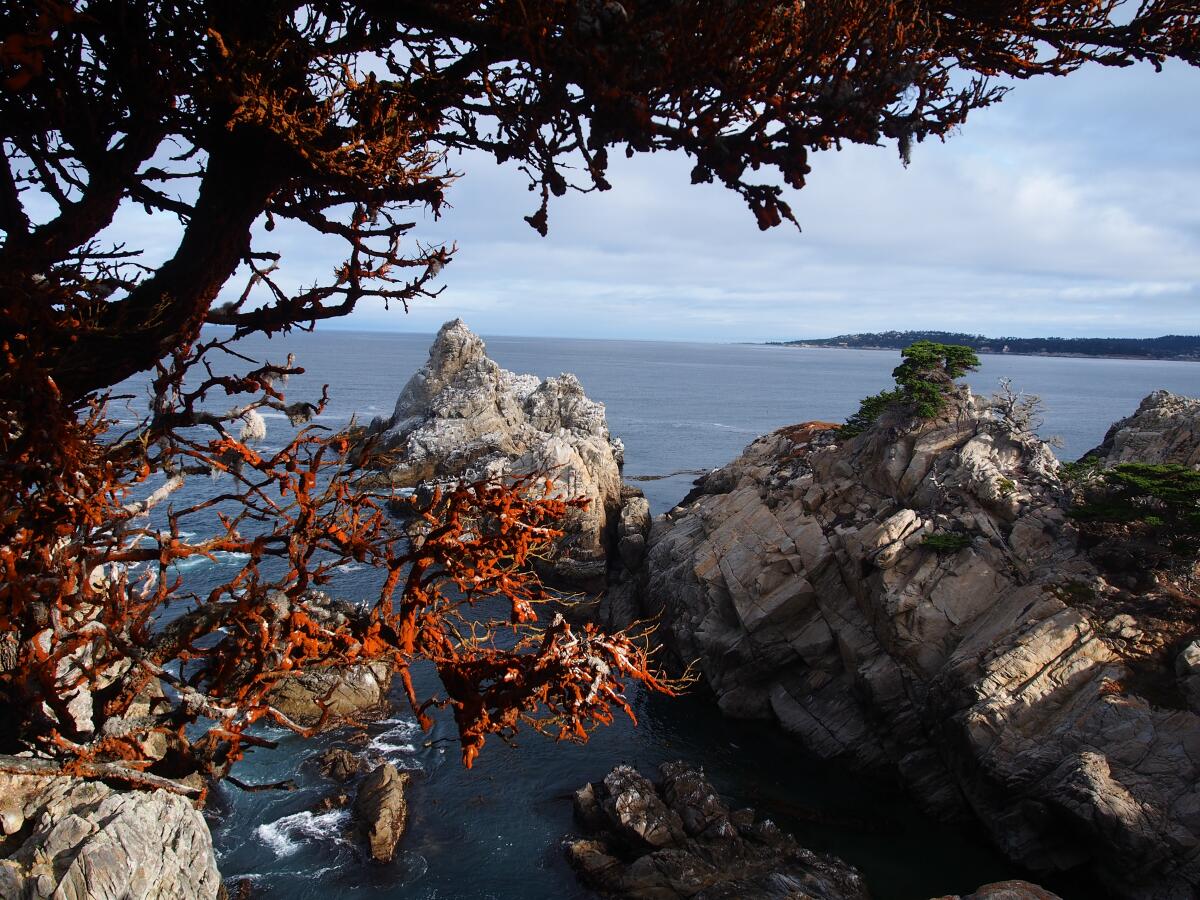Will self-driving cars solve our traffic and street safety problems? A tech historian says no

- Share via
Good morning, and welcome to the Essential California newsletter. It’s Wednesday, March 1.
One common feature in the worlds of science fiction is a future in which humans get where they’re going in a self-driving car. From the Johnny cabs in “Total Recall” to the sleek, vertically driving vehicles in “Minority Report” to the autonomous taxis in HBO’s “Westworld,” mobility means sitting back while your vehicle navigates the world around you.
Fiction is becoming reality — we now have cars that essentially drive themselves. In San Francisco, fleets of Waymo and Cruise cars are picking up passengers, no human driver needed. Self-driving taxis have also rolled out in L.A. Waymo is testing its fleet in a few areas, including Santa Monica, Koreatown and the Miracle Mile. Waymo, Cruise and other players in the autonomous vehicle space talk a lot about how much safer and easier driving could be if cities embraced self-driving cars.
But if the future is so bright, why hasn’t it been a smooth road?
As tech historian Peter Norton told me this week, promises like this — that new kinds of cars will solve the problems caused by our current cars — are nothing new. He argues car companies have worked for roughly a century to “sustain a perpetual overestimate of what cars can do for us.”
The promise — and chaos — of driverless cars
Ambitious goals for driverless cars have been in the news awhile.
The behemoth General Motors has laid out a lofty vision for AVs: “zero crashes, zero emissions and zero congestion.” Back in 2016, Elon Musk told reporters one of his Teslas would be able to drive itself from Los Angeles to New York with “full autonomy” by the following year.
Fast forward to 2023 and that trip has yet to happen — and Tesla has recalled more than 360,000 of its cars due to its faulty so-called Full Self-Driving software. That came after federal regulators from the National Highway Traffic Safety Administration noted the risk of crashes for drivers who engage the experimental feature.
The San Francisco Chronicle mapped out more than 90 incidents documented by the local transit agency “where self-driving taxis created mayhem on city streets — disrupting traffic ... transit and emergency responders.”
Times tech columnist Brian Merchant went for a ride in L.A. in February, and while his trip was fully autonomous, there was a company safety driver behind the wheel. Brian writes:
... the most nerve-wracking thing about the experience may have been the intensity with which the autonomous specialist in the driver’s seat perches her hands over the steering wheel, giving this rider the impression that things could go haywire at any moment, though they never do.
The low-tech problems with a high-tech solution
Norton is an associate professor at the University of Virginia’s Department of Engineering and Society. In his 2021 book “Autonorama: The Illusory Promise of High-Tech Driving,” he explores history to argue that self-driving cars aren’t the solution tech companies and automakers market them as.
“As a historian, I think of myself in a way as contributing to the memory of our society,” he said. “This book is an attempt to sort of jog our memories that we’ve been down this road before.”
Norton pointed to the tobacco industry as a comparable example. Research into the serious health hazards of smoking in the 1950s led to the landmark 1964 surgeon general’s report on smoking.
“That was a very constructive indication that government really can learn and can care about the public interest and do something about it,” Norton said. But the response from tobacco companies was vowing to create a safer cigarette.
“The cigarette companies promised that their amazing filter and their amazing low-tar, low-nicotine tobacco formulation would mean that smoking was going to be safe,” he said.
For Norton, the language being used to pitch self-driving cars indicates we’re “dealing with the same phenomenon.” He added:
For the tech companies and automakers, the equivalent promise now is we can make a car-dependent society a sustainable, affordable, equitable and safe society, and they can’t deliver on any of those. In fact, in every category, they could easily make things much worse.
Norton argues self-driving cars don’t properly address the underlying issues that make driving a dangerous, cumbersome activity — and actually divert attention away from solutions that have worked elsewhere.
Take claims that self-driving cars can fix California’s trademark congestion. If everyone who drives themselves around now started using AVs tomorrow, we’d have the same number of cars on the road. Plus, recent research concluded traffic would actually get worse in urban areas as more people opt for self-driving cars over public transit.
There’s also the role street design and housing policy plays in our car-dependent culture. Our sprawling, low-density suburbs mean we drive more to get to our destinations.
Conversations around autonomous vehicles often steers toward the concept of “Connected Vehicle” technology. That includes the cameras, sensors, lidar, radar and everything else a self-driving car needs to function. But as Norton explained, it’s also being suggested that cities look into “rigging out” their streets with sensors and other hardware — plus equipping people walking and biking with similar tech. That’s an ambitious proposal, to put it mildly.
Norton argues there’s a much more straightforward, proven solution: Build more housing closer to where people need to travel.
“Proximity, in short, is better than all the tech in the world in terms of making mobility safer, with less congestion,” he said.
Then there’s the prevalence of unsafe speeding, which Norton also tied to urban and suburban sprawl. His suggestion: “Create environments where you don’t need speed, because your destinations are close.”
Equity and affordability are concerning for Norton, especially with how expensive autonomous technology is and how car-dependence affects low-income residents.
“Even without autonomous vehicles — so-called — around, we have a world where a lot of people can’t afford a car,” he said. “Then we make a world for them that presumes that they have one — such that if they don’t, they’re in deep trouble. ... If we think that the solution is to develop tech that’s extremely expensive and equip cars with it, we’re doing exactly the wrong thing.”
How else can we fix our problems?
So what would it take to actually address those issues? Norton said first and foremost: “Not letting the people who sell us tech and sell us cars also be the people who tell us what our so-called solutions are.”
“Tech companies and automakers should not be confused with policymakers,” he said. “We have made that confusion very pervasive, and I’m not that optimistic that we’ll resist that successfully.”
Cities, states and federal officials could also do more of the things that have proved to make streets safer and less congested in other, similarly developed nations, Norton suggests. He points to Western Europe, where streets have become safer due to meaningful efforts to bring down vehicle speeds, create more active transportation infrastructure and rethink the public spaces devoted to private cars.
That would require a level of “humility that we have lacked in this country to learn from success stories abroad,” he said. “We have in the U.S. a country that has often been quite proud of itself in a way that makes it unwilling to learn from others.”
And now, here’s what’s happening across California:
Note: Some of the sites we link to may limit the number of stories you can access without subscribing.
L.A. STORIES
Los Angeles County will pay $28.85 million to the family of Kobe Bryant following years of litigation after sheriff’s deputies shared graphic photos of the 2020 helicopter crash that killed the Lakers legend, his daughter and seven other people. The settlement amount is a combination of money for unresolved state law claims with $15 million a jury already awarded to the NBA star’s widow, Vanessa Bryant, after federal court trial last year. Los Angeles Times
If you think the past week of storms have been intense, you would have hated to be an Angeleno in 1938. As Patt Morrison writes, the powerful flooding from that deluge 85 years ago “crashed bridges, knotted railroad trestles, and crumbled highways and roads like soggy saltine crackers.” Patt has many more eye-popping details about that landmark storm and how it changed L.A. in her latest column. Los Angeles Times
Check out "The Times" podcast for essential news and more
These days, waking up to current events can be, well, daunting. If you’re seeking a more balanced news diet, “The Times” podcast is for you. Gustavo Arellano, along with a diverse set of reporters from the award-winning L.A. Times newsroom, delivers the most interesting stories from the Los Angeles Times every Monday, Wednesday and Friday. Listen and subscribe wherever you get your podcasts.
POLITICS AND GOVERNMENT
L.A. County leaders took steps this week to require earthquake retrofitting on certain types of concrete buildings owned by the county or located in its unincorporated areas. The vote from the county’s Board of Supervisors was sparked by the devastating earthquake in Turkey and Syria, where those same types of buildings suffered catastrophic collapse. Los Angeles Times
Support our journalism
HEALTH AND THE ENVIRONMENT
California’s COVID-19 state of emergency has ended. Gov. Gavin Newsom officially rescinded the order Tuesday, just shy of three years since it was declared, back when California had just 53 known cases of the coronavirus. Some other counties also rescinded their orders Tuesday, though L.A. County’s order remains in place until the end of March. Los Angeles Times
SoCal’s slate of winter storms has stranded residents in several communities in the San Bernardino Mountains. Heavy snow has blocked highways and other roads, leaving residents either snowed in at their homes or stuck down the mountain, waiting for the county to clear the roads. But with more snow expected Tuesday and into Wednesday, some residents are rationing food, worried about older neighbors and hoping the power stays on. Los Angeles Times
Bad news for fans of Big Bear’s famous bald eagles: It appears they won’t be welcoming baby eaglets this time around. Experts say Jackie and Shadow’s pair of eggs are unlikely to hatch. Los Angeles Times
CALIFORNIA CULTURE
Over the last year, an event space and entrepreneurial hub in South L.A. has become a community staple of Black life, with local vendors, food live music and more. My colleague Kenan Draughorne wrote about the rise of the Beehive and what it means to Black and Latino Angelenos. Los Angeles Times

California’s so-called Emerald Triangle — made up of Humboldt, Mendocino and Trinity counties — got its name because of the cannabis industry that blossomed there over decades, creating the nation’s key region source for then-illegal weed. But with marijuana now legal in California, residents and business owners are suffering, citing plummeting prices and laws that undermine small growers. CalMatters
Free online games
Get our free daily crossword puzzle, sudoku, word search and arcade games in our new game center at latimes.com/games.
AND FINALLY
Today’s California landmark comes from Jim Hartmann of Altamonte Springs, Fla.: Point Lobos State Natural Reserve.

Jim writes:
Growing up in Berkeley, I always enjoyed spending time at Point Lobos State Natural Reserve just south of Carmel. It’s the state’s most beautiful coastline, a great place to hike and simply reflect on life. I still visit every couple of years as I return to visit family.
What are California’s essential landmarks? Fill out this form to send us your photos of a special spot in California — natural or human-made. Tell us why it’s interesting and what makes it a symbol of life in the Golden State. Please be sure to include only photos taken directly by you. Your submission could be featured in a future edition of the newsletter.
Please let us know what we can do to make this newsletter more useful to you. Send comments to essentialcalifornia@latimes.com.
Sign up for Essential California
The most important California stories and recommendations in your inbox every morning.
You may occasionally receive promotional content from the Los Angeles Times.







